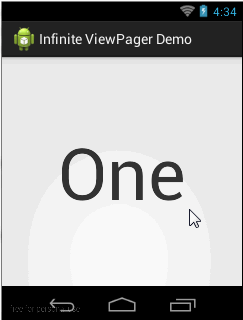I had an idea to do it this way, but there are other ways to do it.
Main
public class MainViewPage extends AppCompatActivity {
ViewPager mViewPager;
int[] mResources = {
R.mipmap.imagem1,
R.mipmap.imagem2,
R.mipmap.imagem3,
R.mipmap.imagem4,
R.mipmap.imagem5,
R.mipmap.imagem6
};
@Override
public void onCreate(Bundle savedInstanceState) {
super.onCreate(savedInstanceState);
setContentView(R.layout.carousel);
mViewPager = (ViewPager) findViewById(R.id.pager);
CarouselAdapter mCustomPagerAdapter = new CarouselAdapter(this, mResources);
mViewPager.setOffscreenPageLimit(1);
mViewPager.setAdapter(mCustomPagerAdapter);
}
}
Adapter
public class CarouselAdapter extends PagerAdapter {
private Context mContext;
private LayoutInflater mLayoutInflater;
private int[] mResources;
private int pos = 0;
public CarouselAdapter(Context context, int[] resources) {
mContext = context;
mResources = resources;
mLayoutInflater = (LayoutInflater) mContext.getSystemService(Context.LAYOUT_INFLATER_SERVICE);
}
@Override
public int getCount() {
return Integer.MAX_VALUE;
}
@Override
public boolean isViewFromObject(View view, Object object) {
return view == ((RelativeLayout) object);
}
@Override
public Object instantiateItem(ViewGroup container, int position) {
View itemView = mLayoutInflater.inflate(R.layout.item_carousel, container, false);
ImageView imageView = (ImageView) itemView.findViewById(R.id.imageView);
imageView.setImageResource(mResources[pos]);
container.addView(itemView);
if (pos >= mResources.length - 1)
pos = 0;
else
++pos;
return itemView;
}
@Override
public void destroyItem(ViewGroup container, int position, Object object) {
container.removeView((RelativeLayout) object);
}
}
XML
In this case of XML, it is already adapted with the CardView
<RelativeLayout xmlns:android="http://schemas.android.com/apk/res/android"
xmlns:card_view="http://schemas.android.com/apk/res-auto"
android:layout_height="match_parent"
android:layout_width="match_parent">
<android.support.v7.widget.CardView xmlns:card_view="http://schemas.android.com/apk/res-auto"
android:id="@+id/card_view"
android:layout_width="250dp"
android:layout_height="250dp"
android:layout_gravity="center|center_horizontal"
card_view:cardElevation="8dp"
card_view:cardCornerRadius="8dp"
android:layout_centerInParent="true">
<ImageView
android:id="@+id/imageView"
android:layout_width="match_parent"
android:layout_height="match_parent"
android:scaleType="centerCrop"/>
</android.support.v7.widget.CardView>
</RelativeLayout>
Screenshots

Take a look at this design Infiniteviewpager, that also has will help to have some more idea of how to do. Below follows an example:



This is @Carlos Giovani casilo, I have not tested but I believe that, assuming you know the number of images you have in your matrix list, if you do something like this in this line
imageView.setImageResource(mResources[position==nrLista?0:position]);would work for Voce– Armando Marques Sobrinho